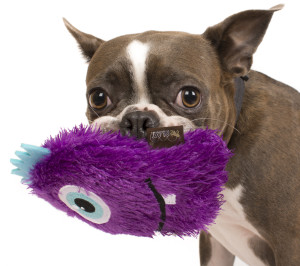Halloween can be a scary time for both pets and owners: during the season, emergency vet clinics grow busy, and corner posts fill with posters of beloved cats and dogs. Maybe that’s why October is also National Animal Safety and Protection month! To keep your pets safe this Halloween, watch out for the following dangers.

With his ID tags and microchip, Franklin is ready to travel anywhere.
Open Doors
It’s easy for a frightened cat or dog to dart out of an open door while you’re tending to trick-or-treaters. To prevent your pet from escaping, keep them in a separate room, or put up a gate.
A microchip and collar will also help your pet to be easily returned if they do manage to get out.
 Costumes
Costumes
While no one can deny that a dog dressed as a dinosaur is beyond adorable, you should always respect your pet’s stress signals. If your cat or dog begins to panic, remove the costume. You may have to downgrade to a festive collar or bandana if they’re too anxious about a full costume.
If your pet loves their suit, great! But supervise whenever they wear it, check that they can still move about freely, and avoid costumes that have easy-to-ingest ribbons and doodads.
 Decorations
Decorations
You know pets: eat first, ask questions later. Don’t let that ‘later’ turn into emergency exploratory surgery. Keep all decorations out of reach, and make sure that candles are kept away from precarious edges.
 Candy
Candy
Dogs are basically year-round trick-or-treaters, and won’t waste an opportunity to grab candy. Artificial sweeteners, chocolate, and raisins can all be toxic to pets, even in small doses, so keep treats out of reach. If you have kids, explain to them why they can’t share their loot with their furry sibling. And of course, some pet-safe treats wouldn’t go astray.
Trick-or-Treaters
Though we all want our pets to be door greeters, some animals just aren’t cut out for it. If your pet is stressed by meeting new people, keep them in a quiet room away from the front with some snacks or toys to keep them busy. If the sound of the doorbell is a stressor, you can turn on some light music to mask the noise.
Even if your pet initially likes greeting people, watch for signs of over-stimulation such as excessive panting, pacing, and turning a deaf ear on your commands. If you live in a busy neighborhood, you may need to alternate greeting with some quiet time.

“Ready to answer the door, greet strangers in costume, and save America.”
Who is this handsome dog, you ask? He’s Franklin, a proud rescue ally! Franklin isn’t up for adoption, but there are many other great dogs (and cats!) waiting for homes. Check out our adoptables page!
Photos by zoography





